Software that makes placemats
-
akzy
- Warre’s Otima 10 year old Tawny
- Posts: 542
- Joined: 21:42 Tue 13 Nov 2018
- Location: Three Bridges
Re: Software that makes placemats
I used the placemats last night for a small tasting among a few physicists. Naturally, we decided to have field lines drawn on. I noted in the manual that Julian is displeased by these and whilst they are good for the majority of the page, some of the lines are non-physical (as circled).
We then went on to discuss how we would do it ourselves (and is a similar method to how I create electric field simulations for trapped ions) . We believe the best option would be to treat each circle as a point charge and then create a potential map (i.e calculate the voltage across the sheet as superposition of each charge) for the entire sheet. From this grid, we can then perform some numerical differentiation (ideally if the point like nature is interpolated with a "reasonable order" function) to create a vector field (which would correspond to the electric field lines). As for visualization, the field lines would be the back-most image and the tasting circles would terminate drawing of lines such that the point charge wouldn't been seen.
Problems i foresee. How on earth do you,
1. Interpolate in PS
2. Differentiate in PS
3. Use PS
For my work I use Mathematica and its fantastic library of simple to use mathematical functions.
Problems i foresee. How on earth do you,
1. Interpolate in PS
2. Differentiate in PS
3. Use PS
For my work I use Mathematica and its fantastic library of simple to use mathematical functions.
Re: Software that makes placemats
• I dislike the whole Rays algorithm. Despite the previous discussion of it way back in summer 2013.
• You say that each circle should be a “point charge”. I suspect that aesthetically that wouldn’t work with the very strong circle motif. The lines need to leave the bounding circle, not a point charge within it. (But each circle cannot be a perfect conductor, as they touch, so would all be at the same charge.)
• Interpolate in Postscript … Differentiate in Postscript. Ans: do the work in Mathematica. Then output it in PostScript. Doh!(Did you really think that the Temple calculations currently in lines 4918–4950 of the code were written by hand?)
• You say that each circle should be a “point charge”. I suspect that aesthetically that wouldn’t work with the very strong circle motif. The lines need to leave the bounding circle, not a point charge within it. (But each circle cannot be a perfect conductor, as they touch, so would all be at the same charge.)
• Interpolate in Postscript … Differentiate in Postscript. Ans: do the work in Mathematica. Then output it in PostScript. Doh!
Code: Select all
(* PostScriptForm — this version of Jan 2019. *)
(* \
PostScriptForm[] *)
(*
\
http://mathematica.stackexchange.com/questions/101954/postscriptform-\
or-forthform
http://mathematica.stackexchange.com/questions/102894/multi-case-\
function-many-single-case-delayed-assignments-or-one-which
*)
Remove[PostScriptForm];
PostScriptForm[thing_Rational] :=
If[Abs[Denominator[
thing]/(2^IntegerExponent[Denominator[thing], 2])/(5^
IntegerExponent[Denominator[thing], 5])] == 1,
ToString[N[thing, 20], InputForm, NumberMarks -> False],
PostScriptForm[Numerator[thing]] <> " " <>
PostScriptForm[Denominator[thing]] <> " div"];
PostScriptForm[thing_?AtomQ] := ToString[thing];
PostScriptForm[thing_List] :=
StringJoin @@ Riffle[Map[PostScriptForm, thing], "\r\n"];
PostScriptForm[MatrixForm[thing_]] := PostScriptForm[thing];
PostScriptForm[Times[-1, thing_]] :=
StringJoin[PostScriptForm[thing], " neg"];
PostScriptForm[thing_Power] := (
psExponent := Which[
# > 5 && Divisible[#, 3],
psExponent[#/3] <> " dup dup mul mul",
# >= 5 && OddQ[#],
"dup " <> psExponent[(# - 1)/2] <> " dup mul mul" ,
# >= 4 && EvenQ[#], psExponent[#/2] <> " dup mul",
# == 3, "dup dup mul mul",
# == 2, "dup mul",
# == 1/2, "sqrt",
# == 3/2, "dup sqrt mul",
# < 0, psExponent[-#] <> " 1 exch div",
(Rational === Head[#]) && (Log[2, # // Denominator] //
IntegerQ), psExponent[Simplify[2 #]] <> " sqrt",
Not[IntegerQ[#]], PostScriptForm[#] <> " exp",
# == 1, "",
True,
" !!!\[Bullet]\[Bullet]\[Bullet]Error with exponent = " <>
ToString[#] <> "\[Bullet]\[Bullet]\[Bullet]!!! "
] &;
Which[
thing[[2]] > 0 || Not[IntegerQ[thing[[2]]]],
PostScriptForm[thing[[1]]] <> " " <> psExponent[thing[[2]]],
thing[[2]] == -1, "1 " <> PostScriptForm[thing[[1]]] <> " div",
thing[[2]] == 0, "1",
True,
"1 " <> PostScriptForm[thing[[1]]] <> " " <>
psExponent[-thing[[2]]] <> " div"
]);
PostScriptForm[thing_Times] :=
StringJoin@
Riffle[Reap[
If[MatchQ[thing[[1]],
Power[_,
n_Integer /; n < 0]], (Sow[
"1 " <> PostScriptForm[thing[[1, 1]]] <> " div"];), (Sow[
PostScriptForm[thing[[1]]]];)];
Map[(If[MatchQ[#,
Power[_,
n_Integer /; n < 0]], (Sow[
PostScriptForm[#[[1]]^(-#[[2]])] <> " div"];), (Sow[
PostScriptForm[#] <> " mul"]; )]) &,
Drop[List @@ thing, 1]]][[2, 1]], " "];
PostScriptForm[thing_Plus] :=
StringJoin @@ If[FreeQ[thing, _^n_],
(* Simple expression, no powers,
to be summed one item at a time *)
Module[{i},
i =
Position[thing, Except[Times[-1, _] | (_?Negative)], 1,
Heads -> False];
If[Length[i] > 0,
i = i[[1, 1]], (i =
Position[thing, Not[MatchQ[#, Times[-1, _]]] &, 1,
Heads -> False]; i = If[Length[i] > 0, i[[1, 1]], 1])];
Prepend[
Map[(" " <>
Replace[#, {(n_Integer /; n < 0 :>
ToString[-n] <> " sub"), (Times[-1, _] :>
PostScriptForm[Times @@ Drop[#, 1]] <> " sub"), (Times[
n_ /; n < 0, _] :>
PostScriptForm[Times @@ Drop[#, 1]] <> " " <>
ToString[-#[[1]]] <> " mul sub"), (Times[
n_ /; n > 0, _] :>
PostScriptForm[Times @@ Drop[#, 1]] <> " " <>
ToString[#[[1]]] <> " mul add"), (_ :>
PostScriptForm[#] <> " add")}]) &,
Drop[List @@ thing, {i}]],
Replace[thing[[
i]], {Times[-1, _] :>
PostScriptForm[-thing[[i]]] <> " neg", _ :>
PostScriptForm[thing[[i]]]}]] ],
(* Polynomial *)
Module[{vars, exps, v, rcl, i, firstMul},
vars = Variables[thing];
exps = Exponent[thing, vars];
v =
Select[Transpose[{vars, exps}], (#[[2]] == Max @@ exps) &][[1,
1]];
rcl = Reverse[Map[Factor, CoefficientList[thing, v]]];
Reap[
i = 1; firstMul = True;
If[rcl[[1]] =!= 1, Sow[PostScriptForm[rcl[[1]]]]];
Map[
If[# === 0,
i++, (Sow[
If[firstMul && rcl[[1]] === 1, PostScriptForm[v^i] <> " ",
" " <> PostScriptForm[v^i] <> " mul "] <>
If[MatchQ[#, (Times[_?Negative, _] | (_?Negative))],
PostScriptForm[-#] <> " sub",
PostScriptForm[#] <> " add"]]; i = 1;
firstMul = False)] &, Drop[rcl, 1]];
If[i > 1, Sow[" " <> PostScriptForm[v^(i - 1)] <> " mul "]];
][[2, 1]]
]];-
akzy
- Warre’s Otima 10 year old Tawny
- Posts: 542
- Joined: 21:42 Tue 13 Nov 2018
- Location: Three Bridges
Re: Software that makes placemats
So I had a quick play (please ignore the asymmetrical crimes against mathematics) around in mathematica doing a point charge simulation, see below for results. Depending on how the circle is placed over, I think it would look ok?
I like the idea of doing it in Mathematica. I presume this is some sort of language converter?
I like the idea of doing it in Mathematica. I presume this is some sort of language converter?
Re: Software that makes placemats
Interesting. What charge did you give each point? By what algorithm should the charges be chosen? And please post the code that made the diagram.
-
akzy
- Warre’s Otima 10 year old Tawny
- Posts: 542
- Joined: 21:42 Tue 13 Nov 2018
- Location: Three Bridges
Re: Software that makes placemats
Below is the code I used. I've changed things slightly so that it can all be solved analytically. Firstly, we define a series of vectors in circlepos which correspond to x,y and charge respectively. Set these however you please (I'd suggest arranging as a n/quadrupole- only because of the work i do https://en.wikipedia.org/wiki/Quadrupole_ion_trap) . The function pot[] then calculates the potential (analytically). This is then summed over all potentials and differentiated in both x and y to produce the field in said directions. StreamPlot is then used to visualise it.
Code: Select all
circlepos = {{1, 1, 1}, {1, 2, -1}, {2, 1, 1}, {2, 2, -1}};
p1 = ListPlot[circlepos, PlotRange -> {{0, 3}, {0, 3}}];
pot[x_, y_, qx_, qy_, q_] := q/Sqrt[(x - qx)^2 + (y - qy)^2]
potgridx[x_, y_] =
D[Total[Table[
pot[x, y, circlepos[[i, 1]], circlepos[[i, 2]],
circlepos[[i, 3]]], {i, 1, Length[circlepos]}]], x];
potgridy[x_, y_] =
D[Total[Table[
pot[x, y, circlepos[[i, 1]], circlepos[[i, 2]],
circlepos[[i, 3]]], {i, 1, Length[circlepos]}]], y];
p2 = StreamPlot[{potgridx[x, y], potgridy[x, y]}, {x, 0, 2.5}, {y, 0,
2.5}];
Show[p1, p2]Re: Software that makes placemats
Yes. Converts basic expressions to (slightly) idiomatic PostScript. Typical use case is a polynomial to be solved: it converts the CoefficientList, which is then passed to a PostScript polynomial solver.
E.g.: PostScriptForm[(a + Sqrt[b])^15] ➝ a b sqrt add dup dup mul dup mul mul dup dup mul mul
Your approach is well suited to circles in a rectangular grid. Not so much in a hexagonal grid. E.g.:
Code: Select all
circlepos = {
{0, 1, 1},
{Sqrt[3.]/2, 0.5, -1},
{Sqrt[3.]/2, -0.5, 1},
{0, -1, -1},
{-Sqrt[3.]/2, -0.5, 1},
{-Sqrt[3.]/2, 0.5, -1},
{0, 0, 1}
};-
akzy
- Warre’s Otima 10 year old Tawny
- Posts: 542
- Joined: 21:42 Tue 13 Nov 2018
- Location: Three Bridges
Re: Software that makes placemats
Love it.
Fixed.jdaw1 wrote: ↑21:04 Mon 17 Jun 2019
Your approach is well suited to circles in a rectangular grid. Not so much in a hexagonal grid. E.g.:Code: Select all
circlepos = { {0, 1, 1}, {Sqrt[3.]/2, 0.5, -1}, {Sqrt[3.]/2, -0.5, 1}, {0, -1, -1}, {-Sqrt[3.]/2, -0.5, 1}, {-Sqrt[3.]/2, 0.5, -1}, {0, 0, 1} };
Code: Select all
circlevec = {{0, 1, 1}, {Sqrt[3.]/2, 0.5, -1}, {Sqrt[3.]/2, -0.5,
1}, {0, -1, -1}, {-Sqrt[3.]/2, -0.5, 1}, {-Sqrt[3.]/2,
0.5, -1}, {0, 0, 1}};
circlepos =
Table[{circlevec[[i, 1]], circlevec[[i, 2]]}, {i, 1,
Length[circlevec]}];
p1 = ListPlot[circlepos, PlotRange -> {{-2.5, 2.5}, {-2.5, 2.5}},
PlotMarkers -> {Automatic, Large}];
pot[x_, y_, qx_, qy_, q_] := q/Sqrt[(x - qx)^2 + (y - qy)^2]
potgridx[x_, y_] =
D[Total[Table[
pot[x, y, circlevec[[i, 1]], circlevec[[i, 2]],
circlevec[[i, 3]]], {i, 1, Length[circlevec]}]], x];
potgridy[x_, y_] =
D[Total[Table[
pot[x, y, circlevec[[i, 1]], circlevec[[i, 2]],
circlevec[[i, 3]]], {i, 1, Length[circlevec]}]], y];
p2 = StreamPlot[{potgridx[x, y], potgridy[x, y]}, {x, -2.5,
2.5}, {y, -2.5, 2.5}];
Show[p1, p2]Re: Software that makes placemats
So do I, but perhaps more for its wilful stubbornness than its practicality.
Hmm. Bug or feature?
• The points south, east-by-north-east and west-by-north-west relate well to the central circle.
• But the points north, east-by-south-east and west-by-south-west do not connect to the central circle at all.
For my palate, this is an offence to symmetry. There’s no a priori reason for the central circle to exhibit such favouritism. You’re trying to squeeze a 2ⁿ pattern into a shape divisible by three, and I think it doesn’t fit.
Others: please take sides.
Some circle arrangements to consider (ignore the decorations):
- 11 June 2019 (14 on /A3);
- 26 Mar 2019 (15 on /A3);
- 13 Feb 2019 (5 on /A4);
- 01 Dec 2018 (6 on /A4);
- 02 Oct 2018 (13 on /A3);
- 10 Oct 2017 (14 on /A3);
- 01 Feb 2017 (9|11 on /A3);
- 24 Feb 2016 (24 on trimmed /A2).
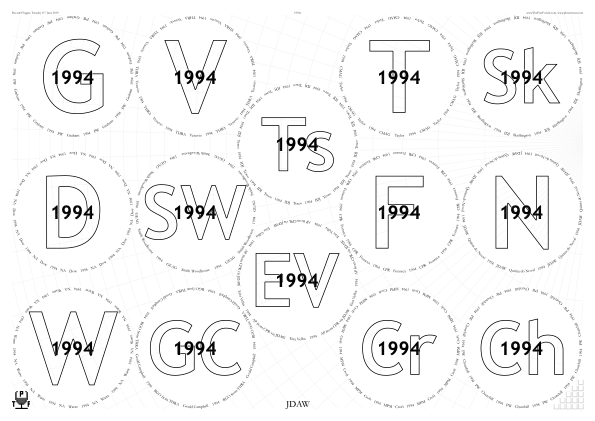
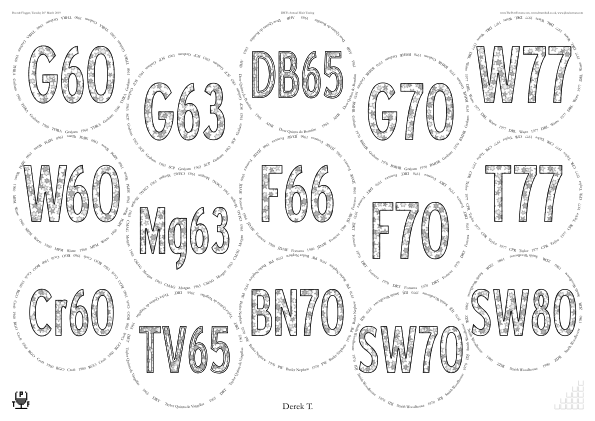
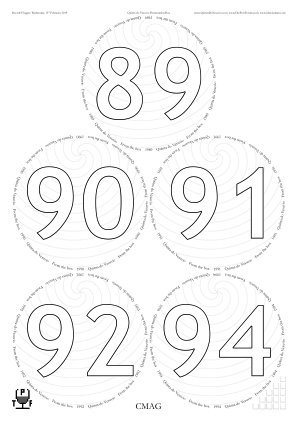
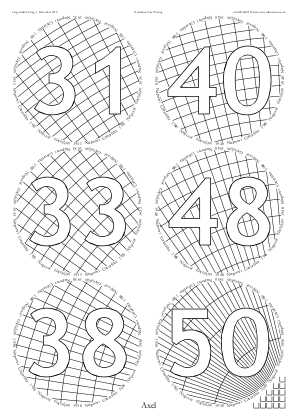
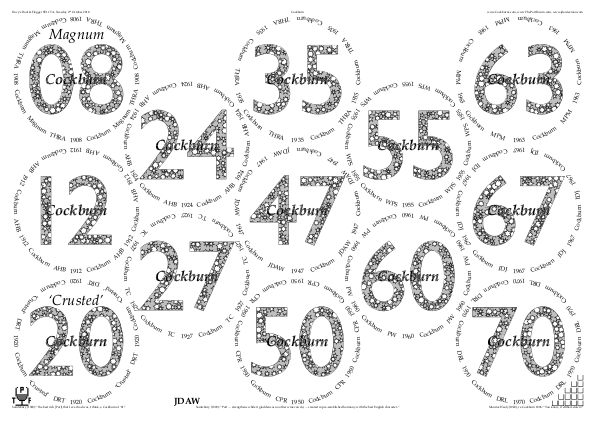
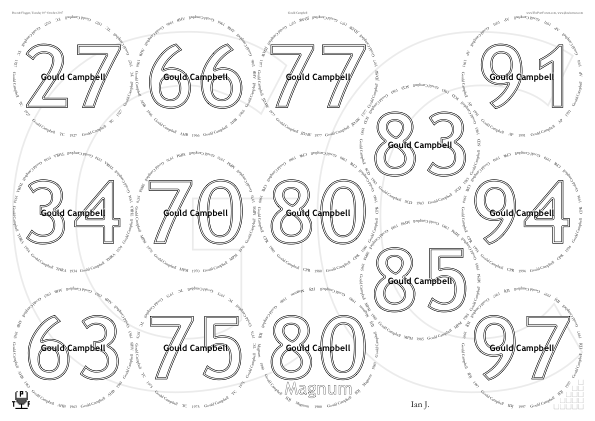
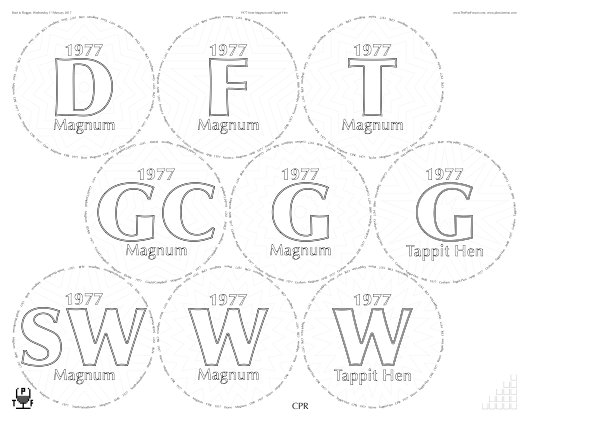
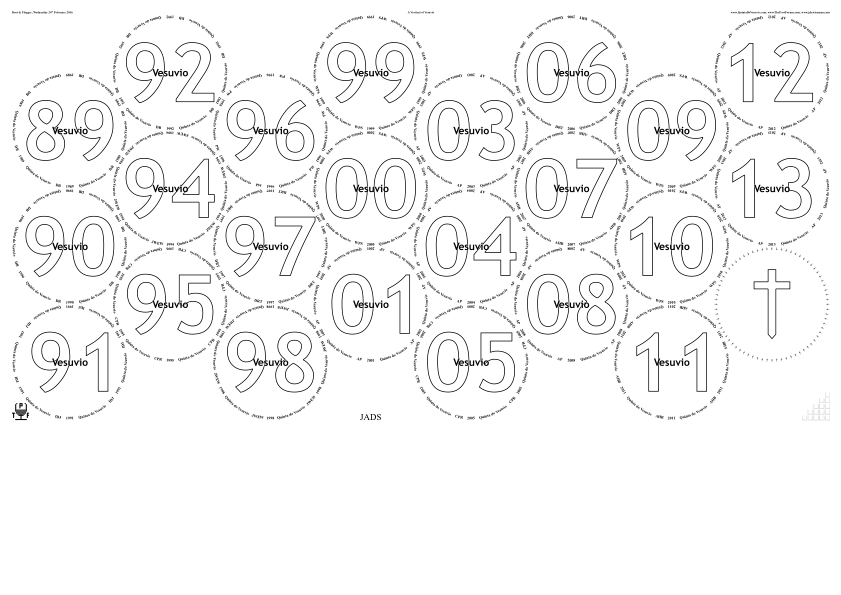
I repeat:
Display: inside the circles is different to outside. Perhaps it should be shown inside faded 60%; and outside at full strength? Comment and recommendation welcomed.
-
akzy
- Warre’s Otima 10 year old Tawny
- Posts: 542
- Joined: 21:42 Tue 13 Nov 2018
- Location: Three Bridges
Re: Software that makes placemats
Obviously a feature.
With the asymmetry, it is bothering me too. I have a suspicion that it's because we're working up against imperfect machine precision. If you plot symmetries in along one plane, you might notice there's a field preference to one side. Perhaps the numbers will have to be adjusted so that they can be positions with exact machine precision? I'll have a play and see what I can muster up.
I'll have a look at some previous placemats soon, see what can be made.
As for the algorithm, I'm really not sure. At least there is a flexibility to have any charge (or even strength of charge for that extra special something).
With the asymmetry, it is bothering me too. I have a suspicion that it's because we're working up against imperfect machine precision. If you plot symmetries in along one plane, you might notice there's a field preference to one side. Perhaps the numbers will have to be adjusted so that they can be positions with exact machine precision? I'll have a play and see what I can muster up.
I'll have a look at some previous placemats soon, see what can be made.
As for the algorithm, I'm really not sure. At least there is a flexibility to have any charge (or even strength of charge for that extra special something).
Re: Software that makes placemats
FYI, the only floating-point precision in PostScript is single: 23-bit mantissa ≈ one part in eight million; 8 bits exponent so maximum value ≈ ±10³⁸.
-
akzy
- Warre’s Otima 10 year old Tawny
- Posts: 542
- Joined: 21:42 Tue 13 Nov 2018
- Location: Three Bridges
Re: Software that makes placemats
Ok, I will try zeroing at 2^-23.
I also had a little play with some other fun field related plots (whilst trying to diagnose). Whilst just a first attempt, and numbers will have to be fudged to make it look better, Plotted using
Code: Select all
ContourPlot[
Log[Total[
Table[pot[x, y, circlevec[[i, 1]], circlevec[[i, 2]],
circlevec[[i, 3]]], {i, 1, Length[circlevec]}]]], {x, -2.5,
2.5}, {y, -2.5, 2.5}, Contours -> 20]-
PhilW
- Dalva Golden White Colheita 1952
- Posts: 3512
- Joined: 14:22 Wed 15 Dec 2010
- Location: Near Cambridge, UK
Re: Software that makes placemats
From the imagery, would I be correct in thinking that each point represents a certain positive or negative charge, and therefore that the reason some points connect to others while others pairs to not is that essentially we are only seeing lines between points of opposite (or different) charge? If so, some variation from binary charge setting would enable alternate maps with all points connecting, though would be potentially difficult to keep regular and symmetrical for all designs without specific rules.
Based on the above, but varying slightly, would making the centre of all circles could be a positive charge, and then placing negative charges between (either in the spaces or the mid-point between adjacent circles) might provide a more fully-connected and symmetric output, though I can't picture whether that might become too linear.
-
akzy
- Warre’s Otima 10 year old Tawny
- Posts: 542
- Joined: 21:42 Tue 13 Nov 2018
- Location: Three Bridges
Re: Software that makes placemats
Good idea. I also changed circlepos to a different hexagonal lattice..PhilW wrote: ↑08:20 Tue 18 Jun 2019 From the imagery, would I be correct in thinking that each point represents a certain positive or negative charge, and therefore that the reason some points connect to others while others pairs to not is that essentially we are only seeing lines between points of opposite (or different) charge? If so, some variation from binary charge setting would enable alternate maps with all points connecting, though would be potentially difficult to keep regular and symmetrical for all designs without specific rules.
Based on the above, but varying slightly, would making the centre of all circles could be a positive charge, and then placing negative charges between (either in the spaces or the mid-point between adjacent circles) might provide a more fully-connected and symmetric output, though I can't picture whether that might become too linear.
Code: Select all
{{0, 2 Sqrt[2], -1}, {Sqrt[2], Sqrt[2], -1}, {-Sqrt[2],
Sqrt[2], -1}, {0, -2 Sqrt[2], -1}, {-Sqrt[2], -Sqrt[2], -1}, {Sqrt[
2], -Sqrt[2], -1}, {0, 0, 1}}- Attachments
-
- hexclosepacked.png (152.29 KiB) Viewed 45785 times
Re: Software that makes placemats
Charges good. Because circles touch, hexagonal was better.
How to generalise the charges it to fit
For this type of layout, might a triangle tesselation with charges {⅓,⅔,1} be correct?
Code: Select all
circlevec = {
{0, 1, 1},
{Sqrt[3.]/2, 0.5, 1/3},
{Sqrt[3.]/2, -0.5, 1},
{0, -1, 1/3},
{-Sqrt[3.]/2, -0.5, 1},
{-Sqrt[3.]/2, 0.5, 1/3},
{0, 0, 2/3}
};
p1 = Map[Graphics[{Red, Thick, Circle[{#[[1]], #[[2]]}, 0.5]}] &, circlevec[[All, 1 ;; 2]]];
pot[x_, y_, qx_, qy_, q_] := q/Sqrt[(x - qx)^2 + (y - qy)^2];
potgridx[x_, y_] =
D[Total[Table[
pot[x, y, circlevec[[i, 1]], circlevec[[i, 2]],
circlevec[[i, 3]]], {i, 1, Length[circlevec]}]], x];
potgridy[x_, y_] =
D[Total[Table[
pot[x, y, circlevec[[i, 1]], circlevec[[i, 2]],
circlevec[[i, 3]]], {i, 1, Length[circlevec]}]], y];
p2 = StreamPlot[{potgridx[x, y], potgridy[x, y]}, {x, -1.6,
1.6}, {y, -1.6, 1.6}];
Show[p1, p2, AspectRatio -> 1]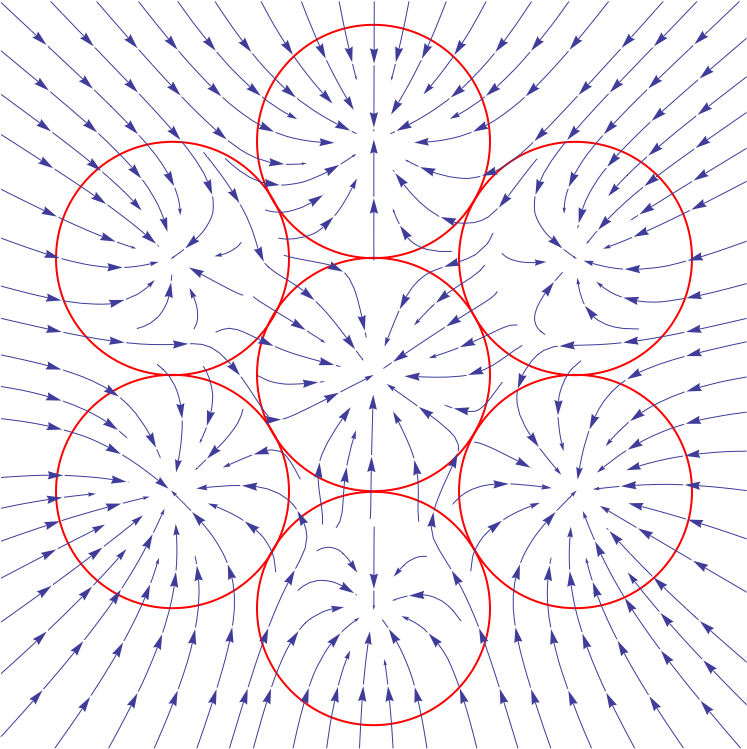
(Alas my Mathematica v9 can’t specify StreamMarkers -> "Segment".)
Re: Software that makes placemats
Edited Wed 19th June to rename Dists ➝ Pot. Please, no jokes.
Possible algorithm for assigning charges
Circles either have a charge assigned (hurray!), which is one of {1,2,3}. Or don’t yet, in which case deemed charge is 0.
Repeatedly we’ll compute, for circle i, Poti0, Poti1, Poti2, and Poti3.
Potik ≡ ∑j ( (xi − xj)² + (yi − yj)² )⁻¹ where j≠i and circle j has charge k.
Pick of the i with no assigned charge the largest value of Poti0÷1024 + Poti1 + Poti2 + Poti3
Assign to it the the charge {3,1,2} according to whichever is smallest of Poti3, Poti1, Poti2, with ties being resolved in that order.
Repeat until all charges assigned.
Observe: easy to code; O(n³) which is acceptable with n≤24; effectively maximises distance between similar charges; starts in centre and chooses circles adjacent to those with known charge, working outwards.
Good? Bad? Improvements?
(But I still have no idea how to compute the streams. Help!)
Possible algorithm for assigning charges
Circles either have a charge assigned (hurray!), which is one of {1,2,3}. Or don’t yet, in which case deemed charge is 0.
Repeatedly we’ll compute, for circle i, Poti0, Poti1, Poti2, and Poti3.
Potik ≡ ∑j ( (xi − xj)² + (yi − yj)² )⁻¹ where j≠i and circle j has charge k.
Pick of the i with no assigned charge the largest value of Poti0÷1024 + Poti1 + Poti2 + Poti3
Assign to it the the charge {3,1,2} according to whichever is smallest of Poti3, Poti1, Poti2, with ties being resolved in that order.
Repeat until all charges assigned.
Observe: easy to code; O(n³) which is acceptable with n≤24; effectively maximises distance between similar charges; starts in centre and chooses circles adjacent to those with known charge, working outwards.
Good? Bad? Improvements?
(But I still have no idea how to compute the streams. Help!)
-
akzy
- Warre’s Otima 10 year old Tawny
- Posts: 542
- Joined: 21:42 Tue 13 Nov 2018
- Location: Three Bridges
Re: Software that makes placemats
I never said it was an efficient packing
As for you algorithm, it seems good. I think seeing it in action will let us know how well it looks.
For manually making a StreamPlot (I think this is what you meant?) I imagine that will be tougher. What I suggest is that we...
1. Create field seed spots at the edges of the circles (at whatever density we decide).
2. At that point, we have a vector (from potgridx and potgridy) telling us where the field goes next.
3. Follow that on some small distance (there is definitely a mathematical way of determining how small this distance is - I cant' remember however).
4. Return back to step 2 until you're off the mat or in another circle.
5. Fit a curve to each trace.
I'm a touch busy atm with pesky thesis writing (we'll forget about a week in Provence coming soon) but if I get some time, I can try have a play with it.
Re: Software that makes placemats
I am absolutely sure it will be very tricky.
Or choose seed points in a small circle around a charge, perhaps every 15°. Flow uphill. But those won’t arrive at even angles at other charges, nor at even distances at edge. Then what? I don’t know.
Also, can the flow uphill be ‘locally’ analytic? If it could be known quite well over a moderate distance, that could be converted to a single Bézier cubic using ApproximatingCurve.
- Alex Bridgeman
- Graham’s 1948
- Posts: 14906
- Joined: 13:41 Mon 25 Jun 2007
- Location: Berkshire, UK
Re: Software that makes placemats
Sorry? Did someone say something?
Wake me up when it's over and someone can explain in English what just happened...
Top Ports in 2023: Taylor 1896 Colheita, b. 2021. A perfect Port.
2024: Niepoort 1900 Colheita, b.1971. A near perfect Port.
2024: Niepoort 1900 Colheita, b.1971. A near perfect Port.
Re: Software that makes placemats
Test implementation of the charge assignment: output looks good — nearby circles have different charges; PostScript code follows.jdaw1 wrote: ↑23:17 Tue 18 Jun 2019Possible algorithm for assigning charges
Circles either have a charge assigned (hurray!), which is one of {1,2,3}. Or don’t yet, in which case deemed charge is 0.
Repeatedly we’ll compute, for circle i, Poti0, Poti1, Poti2, and Poti3.
Potik ≡ ∑j ( (xi − xj)² + (yi − yj)² )⁻¹ where j≠i and circle j has charge k.
Pick of the i with no assigned charge the largest value of Poti0÷1024 + Poti1 + Poti2 + Poti3
Assign to it the the charge {3,1,2} according to whichever is smallest of Poti3, Poti1, Poti2, with ties being resolved in that order.
Repeat until all charges assigned.
Code: Select all
/ParametersVersionDateTimeAdobeFormat (D:201906202330) def
/Circlearrays [ [/lozenge] 15 {dup} repeat pop ] def
/Titles [ ( ) 15 {dup} repeat pop ] def
/Belowtitles [ Titles length {()} repeat ] def
/Names [
(JDAW)
] def
/HeadersLeft [
0 [(Assigning charges: a test)]
] def % /HeadersLeft
/HeadersCenter [
] def % /HeadersCenter
/HeadersRight [
0
{ExternalLinks 2 get}
] def % /HeadersRight
/ExternalLinks [ % Array, length a multiple of three: indented0-boolean, (Descriptor0), (http://URL0), indented1-boolean, (Descriptor1), (http://URL1), ...
false (Thread on ThePortForum.com) (http://www.theportforum.com/viewtopic.php?t=175&start=1136#p112232)
false (Algorithm on ThePortForum.com) (http://www.theportforum.com/viewtopic.php?p=112250#p112250)
false (Latest version this placemat) (http://www.jdawiseman.com/papers/2019/20190620_Charges.pdf)
] def % /ExternalLinks
/VoteRecorders false def
/CorkDisplayNumCopies 0 def
/NeckTagsNumCopies 0 def
/DecantingNotesNumCopies 0 def
/TastingNotePagesNumCopies 0 def
/PaperType { [ /A3 /A4 dup dup dup /A3 dup dup dup] SheetNum get } def
/Orientation {SheetNum 1 eq SheetNum 2 eq or {/Portrait} {/Landscape} ifelse} def % /Landscape /Portrait
/GlassesOnSheets [
[ 7 5 6 5 7 11 13 14 15 ]
{ [ exch 0 exch 1 exch 1 sub {} for ] }
forall
] def % /GlassesOnSheets
/ShrinkRadii /NotAtAll def % /NotAtAll | /ToSmallest | /ToSmallestSamePageOrdering | array denoting equivalence classes
/PackingStyles [
[ /RectangularDislocation /OnlyIfSheetNumMin 1 ]
[ /Diamonds /OnlyIfSheetNumMin 1 ]
[ /DiamondsAndRectangular /OnlyIfSheetNumMin 1 ]
[ /Bespoke5 /OnlyIfOrientation /Landscape /OnlyIfSheetNumMin 1 ]
[ /Bespoke7 /OnlyIfOrientation /Landscape/OnlyIfSheetNumMin 1 ]
[ /RectangularAlternateSplitNudge /OnlyIfSheetNumMin 1 /ImprovementPointsMin 2 ]
[ /DiamondsPlus /OnlyIfOrientation /Portrait /OnlyIfSheetNumMin 1 ]
[ /DiamondsPlus /OnlyIfOrientation /Landscape /OnlyIfSheetNumMin 1 /ImprovementPointsMin 2 ]
[ /RectangularAlternateNudge /OnlyIfSheetNumMin 1 /ImprovementPointsMin 2 ]
[ /Arch /CentralGlasses 1 /GlassesNumMin 6 /OnlyIfOrientation /Landscape ]
] def % /PackingStyles
/PaintBackgroundCode
{
% Done properly, the computations would be in PrologueCode, and only the painting in PaintBackgroundCode.
/Glasses TypeOfPagesBeingRendered eq
{
10 dict begin
/N1s GlassPositions SheetNum get length 1 sub def
/Xs [ GlassPositions SheetNum get {0 get} forall ] def
/Ys [ GlassPositions SheetNum get {1 get} forall ] def
/Charges [ 0 N1s {dup} repeat ] def
/Title 1 string def Title 0 65 put
N1s 1 add
{
/Pot [ 4 { [ 0 N1s {dup} repeat ] } repeat ] def
0 1 N1s
{
/i exch def
0 1 N1s
{
/j exch def
i j ne
{
Pot Charges j get get i 2 copy get 1 Xs i get Xs j get sub dup mul Ys i get Ys j get sub dup mul add div add put
} if % i j ne
} for % j
} for % i
/PotMax -1 def
/iBest -1 def
0 1 N1s
{
/i exch def
Charges i get 0 eq
{
Pot 0 get i get 1024 div Pot 1 get i get add Pot 2 get i get add Pot 3 get i get add
dup PotMax gt {/PotMax exch def /iBest i def} {pop} ifelse
} if % Charges i get 0 eq
} for % i
Charges iBest
Pot 3 get iBest get Pot 1 get iBest get le
{Pot 3 get iBest get Pot 2 get iBest get le {3} {2} ifelse}
{Pot 1 get iBest get Pot 2 get iBest get le {1} {2} ifelse}
ifelse put
TitlesFont RadiiCirclearrayInside SheetNum get 1.9 mul selectfont
GlassPositions SheetNum get iBest get aload pop moveto
GSave nulldevice 0 0 moveto Title false CharPathRecursive PathBBox GRestore exch 4 -1 roll add -2 div 3 1 roll add -2 div rmoveto
[ {/Error} {0.8 setgray} {0.4 0.4 0.5 setrgbcolor} {0.6 0 0 setrgbcolor} ] Charges iBest get get exec
Title ShowRecursive
Title 0 2 copy get 1 add put
} repeat
end
} if
} bind defRe: Software that makes placemats
More realistic example at jdawiseman.com/2019/20190623_Rays_A4.nb.
In the picture green numbers are the charges.
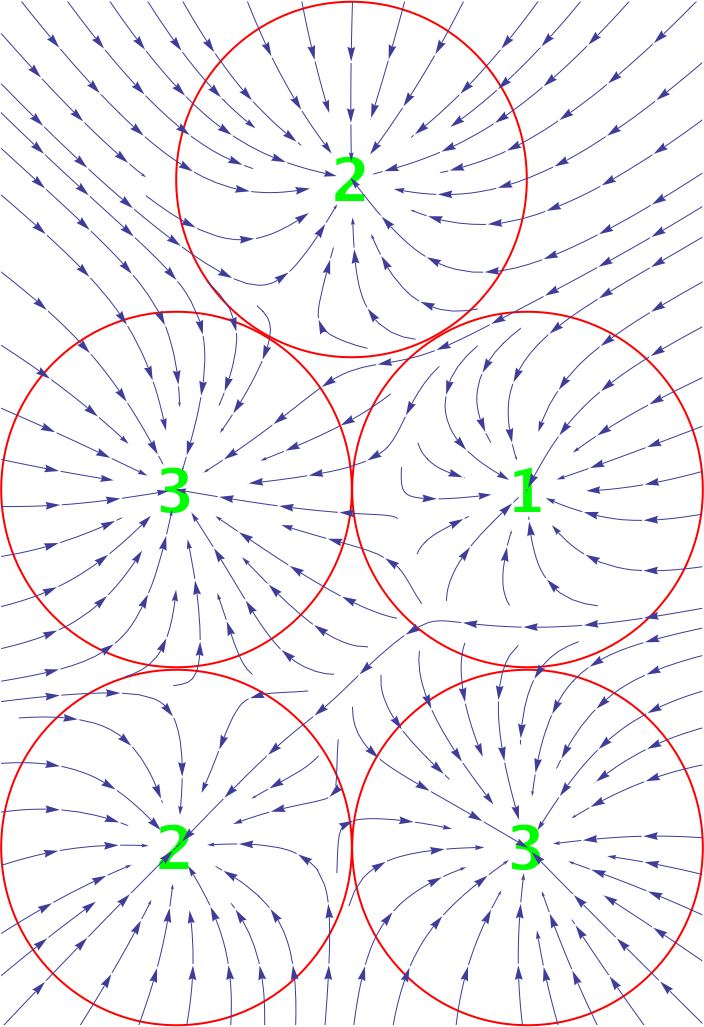
If only StreamPlot weren’t so fiercely difficult to re-code.
Code: Select all
h = 297 (360/127) - 30 - 24;
w = 210 (360/127) - 24 - 24;
r = w/4;
Clear["yy"]; yy = yy /. Solve[(yy - r)^2 == (h - r - yy)^2 + (w/2 - r)^2, yy][[1]];
Print["h=", h, " w=", w, " r=", r, " yy=", yy];
Print[N[circlevec = {
{w/2, h - r, 2},
{r, yy, 3},
{w - r, yy, 1},
{r, r, 2},
{w - r, r, 3}
}] // MatrixForm];
p1 = Map[Graphics[{Red, Thick, Circle[{#[[1]], #[[2]]}, r]}] &, circlevec[[All, 1 ;; 2]]];
p2 = Graphics[Map[Text[Style[#[[3]], FontSize -> 60, Bold, Green], {#[[1]], #[[2]]}, {0, 0}] &, circlevec]];
pot[x_, y_, qx_, qy_, q_] := q/Sqrt[(x - qx)^2 + (y - qy)^2];
potgridx[x_, y_] = D[Total[Table[pot[x, y, circlevec[[i, 1]], circlevec[[i, 2]], circlevec[[i, 3]]], {i, 1, Length[circlevec]}]], x];
potgridy[x_, y_] = D[Total[Table[pot[x, y, circlevec[[i, 1]], circlevec[[i, 2]], circlevec[[i, 3]]], {i, 1, Length[circlevec]}]], y];
p3 = StreamPlot[{potgridx[x, y], potgridy[x, y]}, {x, 0, w}, {y, 0, h}];
Show[p1, p2, p3, AspectRatio -> h/w]
If only StreamPlot weren’t so fiercely difficult to re-code.
-
PhilW
- Dalva Golden White Colheita 1952
- Posts: 3512
- Joined: 14:22 Wed 15 Dec 2010
- Location: Near Cambridge, UK
Re: Software that makes placemats
A suggestion for alternate charge-plan to try and regularise:
- For every circle, inscribe a hexagon (possibly slightly smaller diameter).
- Assign charge to hexagon points (instead of circle centres), all with +1 at top point, then alternating -1/+1 around the hexagon.
In any square or hexagonal arrangement of circles, that should avoid like charges bring close, allowing good connectivity between, while also being regular/simple charge definition for all layouts.
- For every circle, inscribe a hexagon (possibly slightly smaller diameter).
- Assign charge to hexagon points (instead of circle centres), all with +1 at top point, then alternating -1/+1 around the hexagon.
In any square or hexagonal arrangement of circles, that should avoid like charges bring close, allowing good connectivity between, while also being regular/simple charge definition for all layouts.
-
PhilW
- Dalva Golden White Colheita 1952
- Posts: 3512
- Joined: 14:22 Wed 15 Dec 2010
- Location: Near Cambridge, UK
Re: Software that makes placemats
Do you have a pseudo-code algorithm?If only StreamPlot weren’t so fiercely difficult to re-code.
Re: Software that makes placemats
Interesting. I will test. Might the mesh of points be too fine — points too close — such that it loses the macro structure?PhilW wrote: ↑21:23 Sun 23 Jun 2019A suggestion for alternate charge-plan to try and regularise:
- For every circle, inscribe a hexagon (possibly slightly smaller diameter).
- Assign charge to hexagon points (instead of circle centres), all with +1 at top point, then alternating -1/+1 around the hexagon.
In any square or hexagonal arrangement of circles, that should avoid like charges bring close, allowing good connectivity between, while also being regular/simple charge definition for all layouts.
No.
-
PhilW
- Dalva Golden White Colheita 1952
- Posts: 3512
- Joined: 14:22 Wed 15 Dec 2010
- Location: Near Cambridge, UK
Re: RE: Re: Software that makes placemats
My gut feel was that it should be viable for hexagons, but that moving to decagons or higher 2*oddN sided polygons would be too fine. Might/not work, but thought worth suggesting to try.jdaw1 wrote:Interesting. I will test. Might the mesh of points be too fine — points too close — such that it loses the macro structure?
Re: Software that makes placemats
.nb
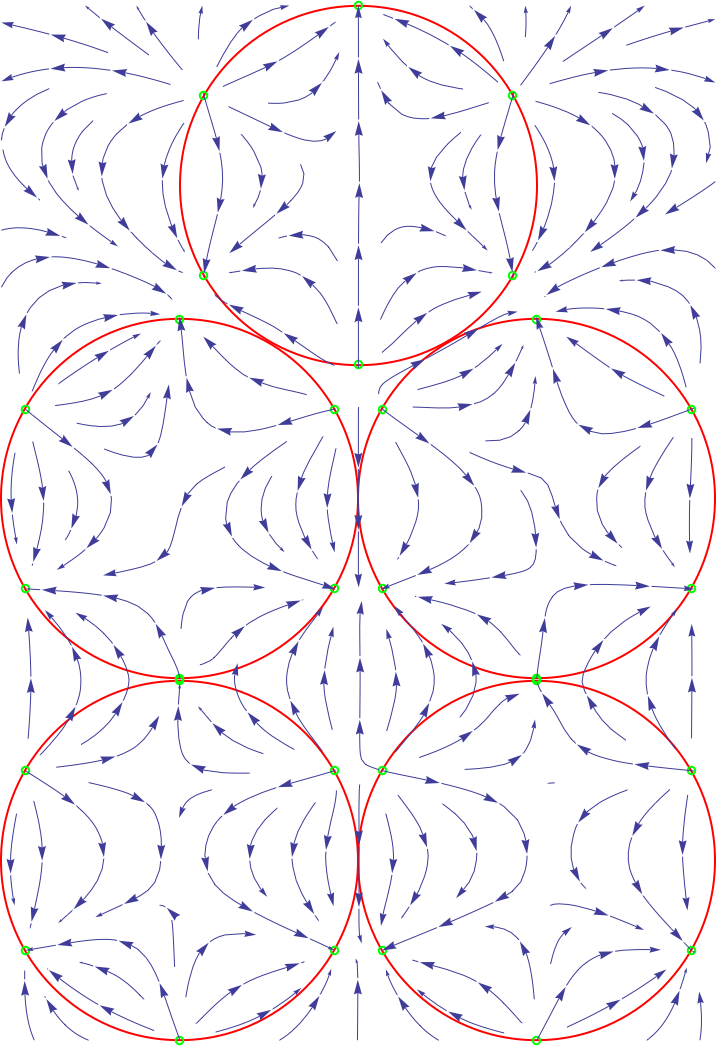
Code: Select all
h = 297 (360/127) - 30 - 24;
w = 210 (360/127) - 24 - 24;
r = w/4;
Clear["yy"]; yy =
yy /. Solve[(yy - r)^2 == (h - r - yy)^2 + (w/2 - r)^2, yy][[1]];
Print["h=", h, " w=", w, " r=", r, " yy=", yy];
Print[N[circleCentres = {
{w/2, h - r},
{r, yy},
{w - r, yy},
{r, r},
{w - r, r}
}] // MatrixForm];
p1 = Map[Graphics[{Red, Thick, Circle[{#[[1]], #[[2]]}, r]}] &,
circleCentres];
charges = Flatten[Map[{
{#[[1]], #[[2]] + r, +1},
{#[[1]] + r Sqrt[3]/2, #[[2]] + r/2, -1},
{#[[1]] + r Sqrt[3]/2, #[[2]] - r/2, +1},
{#[[1]], #[[2]] - r, -1},
{#[[1]] - r Sqrt[3]/2, #[[2]] - r/2, +1},
{#[[1]] - r Sqrt[3]/2, #[[2]] + r/2, -1}
} &, circleCentres], 1];
p2 = Map[Graphics[{Green, Thick, Circle[{#[[1]], #[[2]]}, r/48]}] &,
charges];
pot[x_, y_, qx_, qy_, q_] := q/Sqrt[(x - qx)^2 + (y - qy)^2];
potgridx[x_, y_] =
D[Total[Table[
pot[x, y, charges[[i, 1]], charges[[i, 2]], charges[[i, 3]]], {i,
1, Length[charges]}]], x];
potgridy[x_, y_] =
D[Total[Table[
pot[x, y, charges[[i, 1]], charges[[i, 2]], charges[[i, 3]]], {i,
1, Length[charges]}]], y];
p3 = StreamPlot[{potgridx[x, y], potgridy[x, y]}, {x, 0, w}, {y, 0,
h}];
Show[p1, p2, p3, AspectRatio -> h/w]